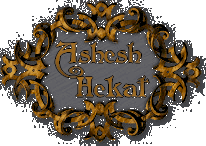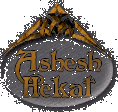
Festival Celebrations

Each festival year represents, to the Witch, the enactment of a myth. (The differences that appear between the varying groups and traditions relate to the differences in choice of myth.) Each festival ritual represents a progressive stage in the myth cycle. This is important, because the myth creates a "picture story" the deep mind can relate to. The myth tells the deep mind "what is happening now."
The ritual actions we will be describing here revolve around the life of the Sacred King, as he is born at Winter Solstice, crowned at Spring Equinox, dies at Summer Solstice, and returns as the Lord of Shadows at Autumn Equinox. In Coven Ashesh Hekat's myth cycle, His cycle interacts with that of the Summer Queen, who is His Mother, Bride, the Lure unto Death, and his Widow.
The following is a brief outline of the Festival Cycle, according to this myth:
THE FESTIVAL CYCLE
Winter Solstice, which takes place on approximately December 21, is the shortest day and longest night of the year. From this point forward, the Sun is in its waxing cycle. We mark this day as the Birth of the Lord of Light; however, the underlying Mystery of this festival is that if the Bright Lord is born, so the Dark Lord must die. Thus at this time, the Dark Lord, who is (as you will see) chosen by lottery at the previous Beltane, will undergo the transition to Bright Lord. His freely-given sacrifice symbolizes that which all men must do in order to be reborn; the entry of the Spirit into the Womb of the Goddess, that it may be transformed into Light. The color of this Festival is white, indicating both the snow and ice of Winter and the white, pure, Infant Light. In the Year Cycle, this time corresponds to midnight.
Candlemas, February 2, is the Festival of the Lady's return from the Underworld. The underlying Mystery here is that although she has already give birth (to the Lord of Light, at Yule), still she is seen as pregnant; pregnant with the seeds of Spring. The return of the Maiden, who is either selected by our current Sun King, or chosen by lottery during the Women's Rite at this time, symbolizes the fresh new life that will renew the Earth during the Spring. As we crown our Maiden and She purifies our Circle, we, too, experience the renewal that is manifest upon the Earth. The color of this festival is pale blue, the color of the Virgin. The time now is first breaking Dawn.
Spring Equinox, is on or about March 21. Now Day and Night are equal. The Lord of Light is becomes manifest as we crown our Sacred King. He, along with the Maiden, will reign until Summer Solstice. During this time, the King will serve the group in many ways. He will visit each member and come to know them better; he will provide advice and council, and he will be available to serve in any way he can. In this way, we all become more personally involved in the Sacrifice that will be made at Midsummer. This is the time of planting and growing. The seeds within the Earth are mature, and their growth cycle may begin. The color of this festival is green, of course, for Spring, and planting, and growth. The time corresponds to full Dawn.
Beltane, on April 30 and May 1. Beltane is the Royal Wedding. Now we perform the Handfasting of the Sacred King and Summer Queen. This is a Festival of Love and Fertility. The marriage of the King and Queen is symbolic of the union of the Sun and the Earth, which results in the fertilization of the seeds that were planted at Spring. At Beltane, we celebrate the fruitfulness of that union, the unspoken implication being that Life results in Death. We know that the joy of Beltane will lead to the Sacrifice at Midsummer, but we are also aware that the Sacrifice will lead to a fruitful Harvest, i.e., Rebirth. at the Evening Ritual on April 30, we hold a lottery to choose the Dark Lord (and eventual King) for the coming year. The color of the festival is pink, for Love and Fertility. The time is Mid-morning.
Summer Solstice, an approximately June 21, is the longest day and the shortest night of the year. This is the time of the symbolic Sacrifice of the Sacred King. All of us share in the Sacrifice at this time, and all of us are within the Goddess who receives it. This Festival will mark the end of the reign of the Sacred King, but the Maiden will now make the transition to Mother, Widow, and Crone. She will continue in that position until she receives the Sacrifice at Summer Solstice the following year. Unseen at this time is the birth of the Dark Lord, who will preside at our Harvest Feast. The Sun is now at its peak and entering its waning phase. The time is high Noon, and the color is gold, for golden Fire and the Sun's golden rays.
Lammas, on July 31 or August 1, celebrates First Fruits of the Harvest. We begin to see our sacrifice brought to fruition. The former Maiden is now the Widow, and is crowned the Queen of the Harvest. She symbolizes the High Fruitful Mother; the Earth. At this time of the Wake of the Sacrificed King, she will discard the flowers of Summer in favor of a crown of Autumn leaves and grain. Her Maiden's crown will be burnt along with the crown of the former King, to mark the passing Season. This is a time of self-examination and Thanksgiving, as we look for the Fruits of the Sacrifice which are becoming manifest in our personal lives.
The Mystery is that the King is present at the Feast, because the Dark Lord is present among us, although we do not yet know his identity. Thus, we invoke the God into the Food we eat, and light a Need Fire to strengthen us for the Harvest period. The Color is now red, for the setting Sun, and the time, of course, is Mid-afternoon, and the first glimpse of Sunset.
Autumn Equinox is approximately September 21; once again, the day and night are equal. The identity of the Dark Lord, who was chosen at Beltane, is at last made known to all, and he is crowned the King of Winter. As the Harvest Lord and Leader of the Wild Hunt, he is the host at our Feast. The King and Queen reign over this festival together, and we celebrate by throwing off old habits and resentments that would weight us down during the winter. Thus, as wheat is separated from chaff, we prune away the unnecessary to better enjoy the Fruitful Harvest that will sustain us during the Dark time. The color of this Festival is brown, the color of fading Earth, and the time is Sundown.
Hallows (or Samhain), on October 31, is the time of the Lady's departure for the Underworld. The Veil Between the Worlds is thin, now, to allow for Her passage, so at this time, when the spirits of our loved ones who have crossed over may return to enjoy our celebration. We honor those who were killed during the Burning Times, and share our Feast with all who have gone before. This is also the New Year celebration, because the Dark Time that begins now will end with the return of the Lady at Candlemas, and we reassure ourselves of the coming of the new Spring. The Crone will perform an oracle for the Circle, so we may see what lies ahead at the end of Winter. The color of the festival is black, the color of Death, truly no color, and yet all of them combined. The time is Midnight.
And so the Wheel turns on and on, whether in the changing of the seasons, or the lifetimes of a soul, or in the lunar month, as the Moon moves through its phases. Always, there are the Cycles. They are unending and unchanging, yet always new. This book describes our efforts to place ourselves in harmony with those changes, and to ultimately lead balanced lives that are in harmony with all the cycles of the Universe. This is the goal of every Pagan, to manifest the Wheel within our lives and become one with Nature.
Our efforts to "bring the Festivals to life" have led us to do things rather differently than many others. Our King, Queen, and Crone, each year, experience the cycles very personally. The rest of us, working closely with them, and interacting with them, also gain a more intimate experience of the turning Wheel. By maintaining "contact" with the appropriate deities through the year, our chosen representatives bring that "God/Goddess energy" into all our lives, and, of course, to our rituals, enhancing our personal awareness of the changes that take place in the nature of those energies during the changing seasons.
Our goal of "reality," rather than "performance," has led us to often celebrate our Festivals for more than one day, and almost always for several hours. The purpose of describing our own work is to give the reader an idea of what "can" be done, not to prescribe how it "should" be done.
So, as our Brother Sylvanus said once (much to his embarrassment, since he had enjoyed the just-finished ritual very much!), "Here's to better rituals."


